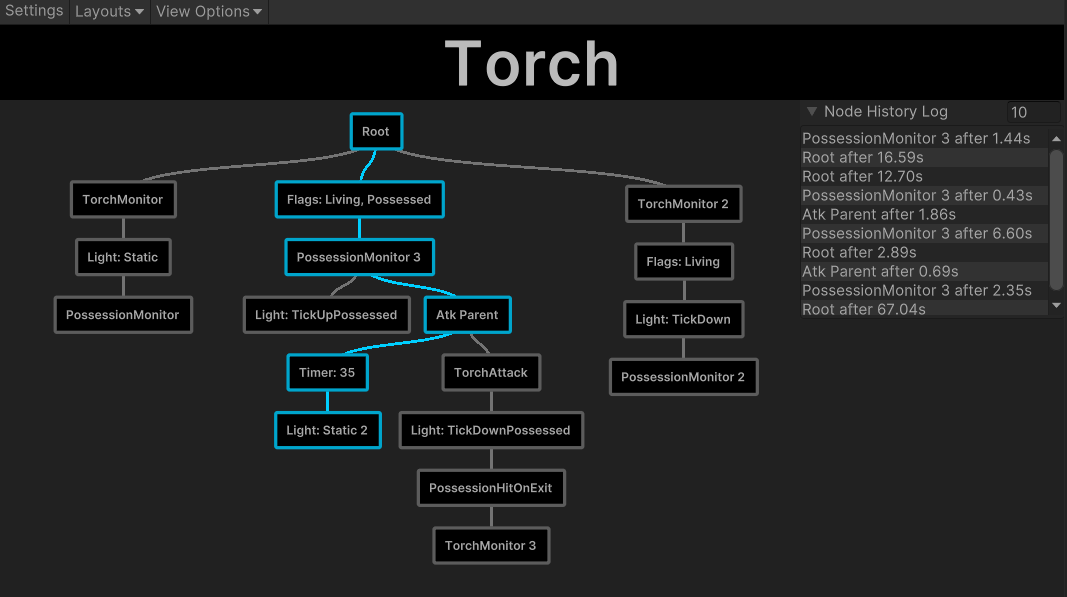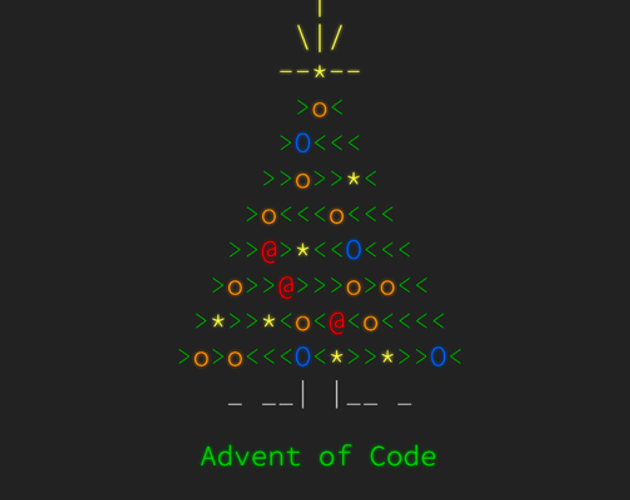Hierarchical State Machines are a spin on finite state machines, where you can be in multiple states within a tree-like Hierarchy at any givin time. For a brief overview of FSM’s and their hierarchical counterparts, you can’t go wrong with Game Programming Patterns.
In Cult of Personality, I used HSM’s to describe all actor behaviour that required anything more than single nested conditional logic. IE, Doors, with just a state of Locked/Unlocked used our NetState system outright, while torches, with behaviour like ticked glows and time queued “burns”, was described using an HSM

The advantage they have over a typical finite state machine is apparent when describing complex behaviour with lots of disparate stateful-ness. Each individual node can stay relatively simple and compact, and behaviour can be easily modified by adjusting the hierarchy and its transitions, as apposed to individual states.
Along with allowing for flexibility over granular changes in behaviour, HSM’s also gave some nice benefits on the networking side. The clearest of those benefits is how easily we can serialize the current state of machine.
code shown omits things like input sanitization for readability. In a production environment, always assume packets are malicious and check for valid ranges!
Serialization
In all games there are certain conditions an actor may be in at any given time. Here’s a few from CoP:
- Moving
- Sneaking
- interacting
- Invulnerability -in elevators & cutscenes
- Timed Stuns
- Light and Heavy Attacks -with various movement restrictions
- Possession -as ghost
Lots of these behaviors are mutually exclusive (while interacting, we know the player can’t be stunned or sneaking), but some are valid combinations that can overlap (players can move while light attacking). In an ideal world, we’d determine which states are exclusive and never send that info over the network. Conversely we’d want to guarantee that valid combinations are always sent.
To achieve that in an HSM-less world, we could add a bunch of behaviour specific logic to our bitpacker. IE “bit x refers to IsSneaking if an earlier bit y referring to IsStunned was true” but what happens if later on a change in actor behaviour affects these exclusion rules? If all of sudden “sneaking while interacting” is a valid combination that lets you interact silently, we’ll need to modify our networking logic along with any gameplay change. icky.
On the flip side, an HSM bakes all of these behaviour exclusions into its structure, so instead of designating specific bits for conditions like IsSneaking or IsStunned, we can just serialize our “walk” down the tree.

Starting at the root, we encode each child as an index out of possible children. Here the decisions are 2nd of 3, 1st of 1, 2nd of 2, 1st of 2, and 1st of 1. We then multiply these choices together based on node depth to create a “header” that encodes the HSM’s current state.
public void SerializeHSM(StreamBuffer outStream)
{
//encode the header
var header = RootNode.SerNode();
outStream.WriteUShort(header);
}
int SerNode(int depthMul = 1)
{
//stop at leaf node
if(_childIndex == -1)
return 0;
var h = _subNodes[_childIndex].SerNode(depthMul*_subNodes.Count);
//encode this child index using the depth multiplier
return h + _childIndex * depthMul;
}
depthMul is the product of every _subNodes.Count above it in the hierarchy, and ensures that each level’s _childIndex is encoded on a separate scale. The caveat here is that the header’s magnitude can vary significantly depending on which subtree the current state ends up in.

For CoP HSM’s the worst-case sits below 2 bytes. These limits are also per HSM, so a smaller HSM’s header requirements can come in under a byte pretty frequently.
To deserialize, we walk back down the tree using the header to decode the next child index as we go.
public void DeserializeHSM(StreamBuffer inStream)
{
//decode the header
var header = inStream.ReadUShort();
RootNode.DeSerNode(header);
}
void DeSerNode(int header, int depthMul = 1)
{
//stop on leaf node
if(_childIndex == -1)
return;
var nextDepthMul = _subNodes.Count * depthMul;
//slice off the relevant header
var moddedHeader = header % nextDepthMul;
//bring it back within the range of child indexes
_childIndex = moddedHeader / depthMul;
_subNodes[_childIndex].DeSerNode(header-moddedHeader, nextDepthMul);
}
We use the fact that each child index was scaled by depthMul to slice the header back into its individual levels, and keep going till we hit a leaf.
Improved Serialization - this technique allows nodes with multiple parents to be serialized without issue. If that isn’t needed, an even more efficient system is described later
Stateful Nodes
Unfortunately, we can’t get by with just serializing the path through the tree. Timed nodes like attacks need to know when they started, and nodes like interaction need to know who/what they’re interacting with.
The good news is that this stateful node info can be serialized during the initial walk through the tree with very little overhead.
First, any Stateful node can implement an interface that marks itself as such.
public interface IStatefulNode
{
void DeSerState(StreamBuffer inStream);
void SerState(StreamBuffer outStream);
}
Then, instead of just building the header in SerNode() we’ll send our streamBuffer along, and from root to leaf let any stateful nodes serialize its extra info
int SerNode(StreamBuffer outStream, int depthMul = 1)
{
//if we're stateful, append our info
if(this is IStatefulNode sNode)
sNode.SerState(outStream);
//...
On the other end, we add the matching method, letting stateful nodes pull the next x bytes as required.
void DeSerNode(StreamBuffer inStream, int header, int depthMul = 1)
{
//deserialize add'l state if necessary
if(this is IStatefulNode sNode)
sNode.DeSerState(inStream);
//...
Because the Hierarchy of the state machine implies a serialized order (from root to leaf), we don’t have to waste bits on flags noting the “next X bytes are for an attack timestamp” and we’ll never waste bits on what’s not there either.
Rollback and Re-Prediction
Hierarchical State Machines adhere to the same core principles as their finite counterparts.
currentState + input = nextState
This implies that given the same starting state, and the same n event inputs, the final state of two identical machines will match. Using that concept, rollback and re-prediction of an HSM can be boiled down to deserializing a confirmed state from the server, then replaying input events from a rolling input buffer.
Machine Transition Delegates
In a typical HSM implementation, you’ll have Enter and Exit delegates that trigger any time the machine transitions. These are still important in a Networked HSM, but more specific delegates for network contexts can also be pretty useful.
- Enter/Exit due to deserialization - allows for ignoring effects that get published in other ways
- Enter/Exit from predicted events - allows for ignoring effects that can’t be predicted
Even better Tree serialization
If you can ensure that each node in the HSM only ever has one parent, (and therefore ensure that there is only one way back to the root node from any leaf node). We can reduce our serialized header size by describing the HSM based solely on our current leaf node’s “index”.

This can be a pretty significant size-reduction! For CoP’s Player HSM we halve our bit requirement, and would need to more-than-double the size of the HSM before we’d need a second byte.
The first step to this technique is doing a bit of pre-processing to actually “index” all the possible leaves. During Init, we’ll start with a depth-first tree traversal.
private void PopulateLeafData(List<int[]> leafCache,
Dictionary<HSNode, index> leafMap, List<int> currentRoute)
{
if(_subNodes.Count == 0)
{
//save the currentRoute into the leaf cache
leafCache.Add(currentRoute.ToArray())
//map this leaf to its index for faster serialization
leafMap.Add(this, leafCache.Count-1);
return;
}
//we know we're not a leaf at this point
for(int i = 0; i<_subNodes.Count; i++)
{
//save this child index to the current route
currentRoute.Add(i);
_subNodes[i].PopulateLeafData(leafCache, leafMap, currentRoute);
//remove this index after processing
currentRoute.RemoveAt(currentRoute.Count-1)
}
}
During our traversal, we keep track of the child indexes we’ve visited inside currentRoute. When we hit a leaf node, we copy that route into leafCache, and map the leaf->index in leafMap.
During serialize, we use leafMap to get the current leaf index, and serialize it as our header.
public void SerializeHSM(StreamBuffer outStream)
{
//leave space for header for after serialization
var headerPos = outStream.Position;
outStream.Position++;
var leafNode = RootNode.SerNode(outStream);
//go back to set the header
var finalPos = outStream.Position;
outStream.Position = headerPos;
//write the leafIndex
outStream.WriteByte(leafMap[leafNode]);
outStream.Position = finalPos;
}
HSNode SerNode(StreamBuffer outStream)
{
//if we're stateful, append our info
if(this is IStatefulNode sNode)
sNode.SerState(outStream);
//stop at leaf node and return its reference
if(_childIndex == -1)
return this;
return _subNodes[_childIndex].SerNode(outStream);
}
SerNode() becomes even simpler because of the pre-processing. Now it just needs to return a reference to the leafNode at the base case.
On deserialize, we use leafCache to retrieve the cached route we need to follow down the hierarchy.
public void DeserializeHSM(StreamBuffer inStream)
{
int leafIndex = inStream.ReadByte();
DeSerNode(inStream, leafCache[leafIndex])
}
void DeSerNode(StreamBuffer inStream, int[] leafPath, int depth = 0)
{
//deserialize add'l state if necessary
if(this is IStatefulNode sNode)
sNode.DeserializeState(inStream);
//stop on leaf node
if(_childIndex == -1)
return;
//update the current child node
_childIndex = leafPath[depth];
_subNodes[_childIndex].DeSerNode(inStream, leafPath, depth+1);
}
This also has the added benefit of eliminating lots of issues stemming from an unbalanced tree, since leaf index is unrelated to depth/width.


